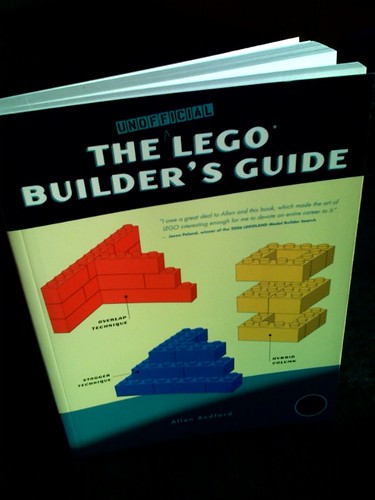
 A lot of LEGO builder books are intended for power users. They employ obscure Technic parts in their projects and assume a level of sophistication beyond the ability of most casual builders. The Unofficial LEGO Builder’s Guide (No Starch) is not one of them! ULBG is directed firmly at beginners, but doesn’t neglect aspiring power users.
A lot of LEGO builder books are intended for power users. They employ obscure Technic parts in their projects and assume a level of sophistication beyond the ability of most casual builders. The Unofficial LEGO Builder’s Guide (No Starch) is not one of them! ULBG is directed firmly at beginners, but doesn’t neglect aspiring power users.
Author Allan Bedford starts out with the basics. What’s the correct terminology for the flat pieces and the wedge-shaped bricks? (Plates and slopes!) What are the best ways to connect bricks to maximize your model’s stability? One section goes into detail about brick storage. After a certain point, the whole “big tub” approach begins to be inefficient because you spend a long time search for the right brick. Bedford offers tips on how to organize your collection.
ULBG is extremely readable, and part of the reason is that Bedford intended his book for two audiences: first, kids in the 7-10 range who had built LEGO products but needed a gentle nudge to create their own designs. Secondly, he thought adults might like it. “I knew that there were latent adult LEGO builders who just needed a bit of information and encouragement in order to be able to begin working on their own models.” To Bedford’s credit, he does not talk down to his younger readers. In true geek tradition, the book is equally readable for both kids and adults.
Chapter 3 of ULBG is all about minifig scale, a GeekDad topic covered extensively in the past few months. Bedford begins the chapter by helping to define just exactly minifig scale is (hint — 1:48) and provides tips on how to build to that measurement. As we covered on GeekDad, pretty soon you start getting to some absurd model sizes. Not surprisingly, Bedford’s biggest model, a CN Tower featured in numerous LEGO conventions, is not actually to minifig scale. “The tower is roughly to scale.” Bedford explained. “If you had to put a number on it, I would suggest it’s around 1:180. That’s much smaller than minifig scale, of course. If it had actually been built to minifig scale it would be nearly 40 feet tall.”
Perhaps one of the most ambitious sections of the book is the Brickopedia, where Bedford describes some 300 different kinds of LEGO pieces. “Deciding which bricks to include (and not include) was indeed a challenge,” he said. “I looked for bricks, plates, slopes and so on that I felt best represented the ‘basic’ LEGO pieces with which most readers would be familiar. Of course, I also included Technic parts, decorative elements and things like cones, baseplates and windows. Even though you could argue some of those pieces are slightly more specialized, they are all very useful and reusable in their own right.”
The Brickopedia has proven such a dazzling success that Bedford is working on a stand-alone Brickopedia book, with full-color photographs of all the pieces described in ULBG, as well as some new pieces from the last few years. Look for it in late 2008.
ULBG is a clearly written and informative resource, an essential for any aspiring brickmeister whether adult or kid. By not intimidating casual builders, this resource empowers these readers to take the next level on their own.
Click to download a sample chapter courtesy of No Starch.

